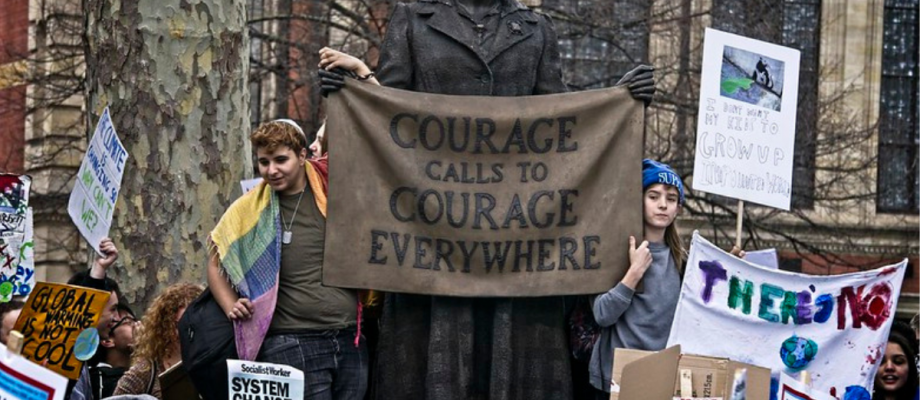By Kirsty Campbell
The climate emergency has been, as it so often is, pushed to the sidelines when more evidently immediate dangers emerge. Global lockdowns have hampered the visibility of the climate movement just at the moment when international climate strikes were making headlines and forcing politicians to take the issue seriously. However, the pandemic and the rising temperature of the planet should not be seen as distinct and separate issues. If anything, the spread of COVID-19 should highlight the immediate dangers and potential future catastrophes of an ever-encroaching global climate crisis.
Whilst there is no direct proof that climate change has influenced the spread of COVID-19, there are clear connections between climate change and interactions between humans, the Earth, and other species. Dr. Bernstein, director of Harvard’s Chan C-CHANGE, explains: ‘As the planet heats up, animals big and small, on land and in the sea, are headed to the poles to get out of the heat. That means animals are coming into contact with other animals they normally wouldn’t, and that creates an opportunity for pathogens to get into new hosts.’ Additionally, he points out that the factors increasing the risk of pandemics lie rooted in climate change, such as deforestation, loss of animal habitats, and large livestock farms (Bernstein, 2020). Thus, rather than overshadowing the climate emergency we face, the COVID-19 pandemic should be a call to action, a clear warning of the potential future disasters that a continued rise in global temperatures may cause.
Indeed, the pandemic provides the potential to act as a turning point in the fight against climate change. The widespread collapse of the global economy will call for a reconstruction of economies around the world. If this reconstruction is shaped around environmental aims, with investments in green energy and green sectors of the economy, we could achieve two goals often falsely understood as being antagonistic. A green economical re-construction would build a world prepared for the future, crafting both a sustainable economy and crucial first steps in the fight against climate change. Unfortunately, there are a number of issues that indicate the potential for the relegation of environmental concerns in a post-pandemic reconstruction.
Newspaper headlines this year posited the positive news that we are set to have the ‘largest ever annual fall in CO2 emissions in 2020’. This is based on estimates by Carbon Brief, who claim that ‘the pandemic could cause emissions cuts this year in the region of 2,000m tonnes of CO2 (MtCO2)’, amounting to the equivalent of around 5.5% of the global total of 2019 (Evans, 2020). Previous global crises, for example the 1918 Spanish Flu and the 2008 economic crash, have often led to a drop in CO2 emissions. Yet history also serves as a warning sign: after both crises, most notably following the 2008 economic crash, global economic recovery instead saw a sharp rise in CO2 emissions. In fact, following the drop in emissions after the 2008-9 recession, the world saw an increase in CO2 emissions of almost 6% in 2010, much exceeding the pre-recession global emissions (McGrath, 2020).
Scientists warn us to be cautious of these figures as their cause is related to short-term, individual choices. This year the decline in CO2 emissions has been connected to lockdowns around the world which have led to altered consumer patterns and reduced transport (Le Quéré, 2020). Carbon Brief has pointed out that in order to limit global warming to 1.5°C above pre-industrial levels, global emissions would have to drop by 7.6% annually every year. Despite the drastic changes to individual consumer demands and reduced travel brought about by the pandemic, this target has not even been reached this year. Carbon Brief states: ‘To put it another way, atmospheric carbon levels are expected to increase again this year, even if CO2 emissions cuts are greater still. Rising CO2 concentrations – and related global warming – will only stabilise once annual emissions reach net-zero’ (Evans, 2020).
As Adam Vaughan points out, ‘Climate change hasn’t stopped because of a global pandemic. Yet our turbocharged heating of Earth has become an almost forgotten crisis’ (Vaughan, 2020). A false emphasis on this year’s drop in CO2 emissions, based on a unique pandemic situation, could incorrectly lead to a belief that the world is on the right path to combating the climate emergency, and that other issues, such as an economic recovery, must now take centre stage.
Indeed, some go even further and claim that the climate emergency is not real, despite extensive scientific proof of it. Right-wing lobby groups and politicians across the world are opposing green new deals and spreading disinformation while media groups such as The Australian and The Wall Street Journal are undermining the link between human emissions and extreme weather events. The Climate Intelligence Foundation, a European climate science denial group with connections to a number of British Conservatives and comparable parties in the European parliament, recently called on leaders to ‘fight the virus not carbon’. Another increasingly common argument against a green economic reconstruction is that it is ‘poor value for money and climate risks are exaggerated.’ Far-right politicians have shifted their focus from an outright denial of the climate crisis, which has become almost impossible to refute due to the experiential evidence, to ideological critiques. In Brazil, politicians are implying that climate campaigns are a global Marxist plot and that environmental NGOs focused on the Amazon are part of an international conspiracy to stifle economic development (Watts, 2020).
Some major political and economic stakeholders are currently moving beyond rhetoric to action. Rather than moving towards green new deals in the hope of reconstructing their economies following the pandemic, some countries are investing in so-called ‘dirty’ industries to restart their economies. In Brazil, the state-led oil company Petrobas recently sold its shares in renewable energy demonstrating a visible shift away from a green economy future, while Xi Jinping, President of China, who recently promised to make China carbon-neutral by 2060, only put aside 0.3% of its stimulus package for renewables and other sustainable projects (Watts, 2020). Yet this is not a trend limited to Brazil or China. A recent study conducted by The Guardian has found that ‘in at least 18 of the world’s biggest economies, more than six months after the first wave of lockdowns, pandemic rescue packages are dominated by spending that has a harmful environmental impact.’ Indeed, the same article claims that ‘only four countries—France, Spain, the UK and Germany—and the EU have packages that will produce a net environmental benefit’ (Harvey, 2020).
Moreover, ‘the economic crisis associated with COVID-19 is markedly different from previous economic crises in that it is more deeply anchored in constrained individual behaviour’ (Le Quéré, 2020). Thus, the recent drop in CO2 emissions currently being celebrated is in fact not due to governmental or industry reforms but changes in individual behaviour on a global scale. That even these cannot cause emissions to drop by the 7.6% that is required demonstrates that the solution to the climate crisis lies not in individual choices and behaviours, but in structural changes implemented by governments and industries.
Whilst these projections make for a bleak forecast for the future, we can’t assume that the time for ethical and sustainable decision-making is gone. In fact, the potential of a green reconstruction still exists, as long as the right emphases are made now. That is precisely why COP26 2021 will play such a pivotal role in the tipping point for a green future. The upcoming UN climate change conference could re-assert and strengthen a global coalition in the fight against the climate crisis. Indeed, economics professor Ed Barbier points out, ‘there is huge potential for boosting employment, particularly in construction’ in a green recovery (Harvey, 2020). If the potential in green economies is highlighted at Glasgow’s COP26, the need for an economic recovery due to the pandemic could stimulate interest in creative and green solutions. Alternatively, it could see renewed relegation of the issue of the climate emergency in the face of more short-term and national concerns.
Yet there are reasons to be positive. American President elect, Joe Biden’s promise to re-join the Paris Climate Agreement and his ambitious national plans could serve as an impetus for other countries to follow. Indeed, some analysts have optimistically pointed out that America’s ambitious plans, if Biden manages to implement them with the US Senate, could serve as a kick-starter for a ‘race’ between countries to become green and thereby assert themselves on a global scale (Harvey, 2020).
Thus, COP26 can serve as a pivotal moment, signalling either the strengthening or the collapse of a global response to the climate emergency and provide the tipping point we need for a green future. It is the place in which the goals of the Paris Climate Agreement can be forcefully re-asserted and the extent to which countries are reaching them critically considered—finding solutions and putting pressure on these nations if they are not meeting targets. For the climate crisis impacts everybody around the world and can only be successfully limited if all countries fight against it. As Corinne Le Quéré points out, ‘government actions and economic incentives postcrisis will likely influence the global CO2 emissions path for decades’ (2020). Whilst politicians will be the main parties attending the conference and dictating its outcomes, it is up to civil society and the public at large to remind politicians of the urgency to combat the climate crisis.
Kirsty Campbell is part of the team facilitating Arkbounds upcoming publication on the climate crisis. Find out more about the COP26 project here.
Bibliography
Bernstein, A. (2020) Coronavirus, Climate Change, and the Environment. [online] C-Change. Available at: https://www.hsph.harvard.edu/c-change/subtopics/coronavirus-and-climate-change/. [Accessed 9 Nov. 2020]
Evans, S. (2020) Analysis: Coronavirus set to cause largest ever annual fall in CO2 emissions. [online] Carbon Brief. Available at: https://www.carbonbrief.org/analysis-coronavirus-set-to-cause-largest-ever-annual-fall-in-co2-emissions. [Accessed 9 Nov. 2020]
Harvey, F. (2020) Revealed: Covid recovery plans threaten global climate hopes. The Guardian, [online] Available at: https://www.theguardian.com/environment/2020/nov/09/revealed-covid-recovery-plans-threaten-global-climate-hopes. [Accessed 13 Nov. 2020]
Le Quéré, C. et al. (2020) Temporary reduction in daily global CO2 emissions during the COVID-19 forced confinement. Nature Climate Change, [online] 10, 647-653. Available at: https://www.nature.com/articles/s41558-020-0797-x [Accessed 12 Nov. 2020]
McGrath, M. (2020) Climate change and coronavirus: Five charts about the biggest carbon crash, BBC News [online] Available at: https://www.bbc.com/news/science-environment-52485712. [Accessed 11 Nov. 2020]
Vaughan, A. (2020) How the coronavirus has impacted climate change – for good and bad. [online] NewScientist. Available at: https://www.newscientist.com/article/mg24833040-900-how-the-coronavirus-has-impacted-climate-change-for-good-and-bad/#ixzz6ehxXsBba. [Accessed 11 Nov. 2020]
Watts, J. (2020) Five post-Trump obstacles to a global green recovery. The Guardian, [online] Available at: https://www.theguardian.com/environment/2020/nov/11/five-post-trump-obstacles-to-a-global-green-recovery. [Accessed 13 Nov. 2020]








